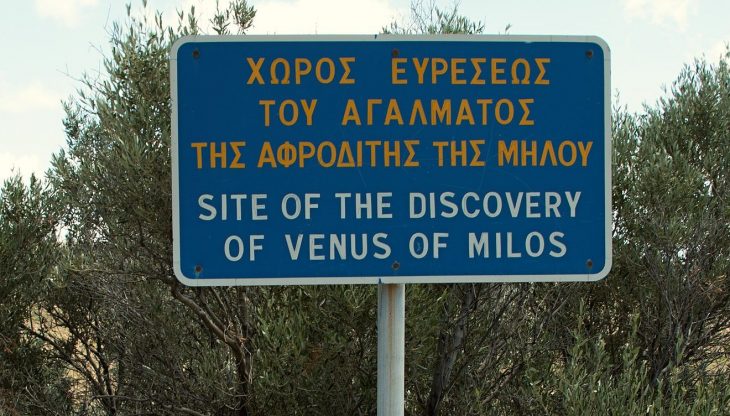This summer I visited the Greek island of Milos, one of those tiny specks in the Aegean Sea that takes a half-hour flight from Athens to reach. The postcards you find there show its beautiful coastline, the vivid white plaster Cycladic houses and their deep marine blue shutters, the pirate caves of Papafragas and Kleftiko, and the volcanic rocks of Sarakiniko that look more like a lunarscape than part of the Mediterranean. And then there is the statue of Venus.
Days into our stay, my mother and sister and I took a bus ride that promised to visit all the locations on the postcards, including a stop marked ‘Venus’. A few hours into the journey we pulled up at the top of a hillside on the inner north-west of the horseshoe-shaped island. The setting was dramatic, with the coastline below us and a breeze ruffling through the pine trees and bushes of mint, basil and sage. Our guide told us the statue had been discovered here in 1820 by an islander, who found it buried in some ancient ruins. He had a detached expression. Right here, he said, a loose hand gesturing vaguely as he walked off, telling us to reconvene at the bus in a half hour.
Where? There were trees and immediately below us the ruins of a Roman amphitheatre. I turned to my mother, who looked as confused as me. We walked a little further until we reached a placard, faded over time but with text in Greek and English. ‘Venus di Milo’, it announced. The paragraph repeated what our guide had just said and then, at the bottom, the same photograph I had seen in all the postcards, and two words that read like the villain’s name in a story: ‘Louvre, Paris’.
I live in Paris. Every morning on my way to work I cross the cobbled square courtyard of the Louvre. I did not think of this as I stood on that hilltop in Milos with only a photograph of Venus to look at. For the first time I felt something of the bitter loss of the plundered. At university I had lived around the corner from the British Museum and used a shortcut through the Great Court to get to my classes. In the dispute between Greece and Britain over the Parthenon Marbles, removed from the Acropolis and taken to London in the early 19th century, I had unhesitatingly supported those who argued against cultural specificity and defended the universal value of grouping artworks together in world museums.
There is some debate over how Venus made it to France, but in the Louvre narrative the Marquis de Rivière, a French ambassador to the Ottoman empire at the time of her discovery, purchased the statue and offered it to Louis XVIII, who swiftly donated it to the Louvre. Apart from an evacuation to a castle during the Second World War, Venus has been in Paris for nearly two centuries.
When I returned from Greece I went looking for the real thing. On a hot weekday morning I pushed my way through the human conveyor belt inside the Louvre on a one-way track to the Mona Lisa. The Venus de Milo has a room to herself. It is filled with natural light coming in from a big window to the left. When I set my eyes on her I stopped short. There she was! I had not been prepared for her size. A little larger than life, and higher, too – the Louvre has given her a marble pedestal to stand on though she is already more than two metres. My eyes were about level with her feet. I stood for a long time looking up at her, from the side, from behind. No postcard shows her from this angle, perhaps because there is nothing godlike about her exposed, hunched shoulders and the drape falling to reveal the top of her bottom; she looks merely vulnerable.
It is difficult to reconcile the bitter disappointment I felt in Milos with my sense of wonder looking up at Venus in the Louvre. I like to think of the millions of people every year who come to see her, so majestic up there on her plinth. But it is also difficult to forget my guide’s nonchalant wave of the hand; the gesture that captured what he and the 5,000 other islanders on Milos have lost.
From the September 2018 issue of Apollo. Preview and subscribe here.
